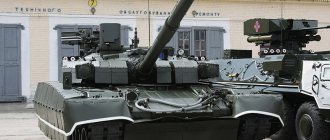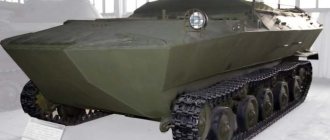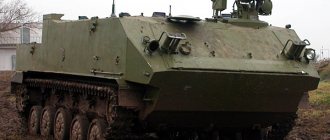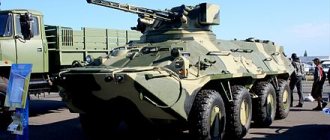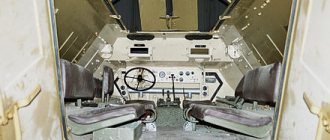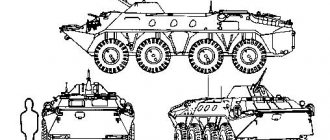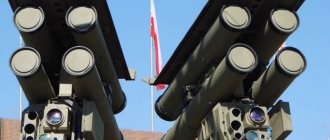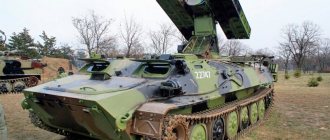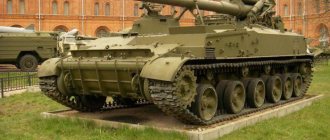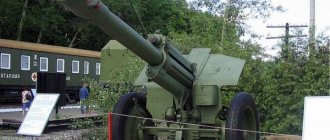29.04.2019
The Soviet light armored personnel carrier BTR-40 is the first wheeled armored vehicle used to transport military units on the battlefield in conditions of direct fire contact with the enemy. The vehicle was created as a means of strengthening and increasing the mobility of the actions of rifle units during the combat deployment of formations on the battlefield.
Development and serial production
After the end of World War II, the Soviet armed forces clearly recognized the need to have an armored transporter as part of their rifle units. The experience of using American armored vehicles supplied to the USSR under Lend-Lease at the final stage of the war showed how the mobility and firepower of rifle units immediately increased.
Soviet designers began developing a similar machine in 1947. It was decided to use the chassis of the Soviet GAZ-63 truck as the wheelbase. They decided to take the main structural elements for the first domestic armored personnel carrier from the American M3 vehicle. The development was carried out by the Design Bureau of the Gorky Automobile Plant. The prototype entered sea trials in 1949.
Landing of a motorized rifle unit from a light armored personnel carrier BTR-40.
August 1952 The created vehicle turned out to be universal and could be used as a transporter for personnel of motorized rifle units, a reconnaissance vehicle and as an artillery tractor. Serial production of the first domestic armored personnel carrier BTR-40 was carried out from 1950 to 1960. Soviet industry supplied the troops with about 8.5 thousand vehicles in two modifications.
Operators
BTR-40 operator map
Modern
- Burundi - 20 BTR-40, as of 2020
- Vietnam - up to 100 BTR-40, as of 2020
- Guinea - 16 BTR-40, as of 2020
- Guinea-Bissau - 35 BTR-40, as of 2020
- Egypt - 230 BTR-40 units, as of 2020
- Indonesia - 40 BTR-40, as of 2020
- Yemen - a number of BTR-40s, as of 2016
- DPRK - a number of BTR-40s, as of 2016
- Cuba - up to 100 BTR-40, as of 2020
- Laos - 30 BTR-40 and BTR-60, as of 2020
- Mongolia - up to 200 BTR-40, as of 2020
- Nicaragua - up to 20 BTR-40, as of 2020
- Tanzania - about 10 BTR-40 and BTR-152, as of 2016
Former
- Algeria - 100 BTR-40 units were supplied from the USSR between 1967 and 1967
- Angola - 32 BTR-40 units delivered from the USSR in 1975
- Afghanistan - a number of BTR-40s, as of 2010
- Bulgaria - 150 BTR-40 units were supplied from the USSR between 1957 and 1957
- Hungary - 200 BTR-40 units delivered from the USSR in 1953
- GDR - 300 BTR-40 units were supplied from the USSR between 1957 and 1957
- Israel - 6 BTR-40, as of 2010
- China - 100 BTR-40 units were supplied from the USSR between 1960 and 1960, then produced in China under the designation "Type 55"
- Mali - 30 BTR-40, as of 2010
- Poland - 400 BTR-40 units were supplied from the USSR between 1955 and 1955
- Northern Yemen - 70 BTR-40 units delivered from the USSR in 1961
- Serbia and Montenegro - 40 BTR-40 units delivered from the USSR in 1962
- Syria - a number of BTR-40s, as of 2010
- Somalia - 60 BTR-40 units delivered from the USSR in 1965
- Uganda - 10 BTR-40 units were supplied from the USSR between 1970 and 1970, 50 BTR-40 units were supplied from the USSR between 1975 and 1975.
- Ethiopia - 100 BTR-40 units were supplied from the USSR between 1978 and 1978
- South Yemen - 60 BTR-40 units delivered from the USSR in 1973
Main tactical and technical characteristics of the BTR-40 armored personnel carrier
- Crew - 2 people, landing party - 8 people.
- Combat weight - 5.3 tons.
- Length - 5 m, width - 1.9 m, height - 1.83 m, ground clearance - 276 mm.
- Armament: 7.62-mm SGMB machine gun (ammunition - 1250 rounds).
- Armor thickness: 4-15 mm.
- Carburetor engine, power - 78 hp.
The Soviet armored personnel carrier BTR-40 was in service with motorized rifle units of the Soviet Army until the mid-60s. The last vehicles were removed from service with the Russian army only in 1993. The Soviet BTR-40 was in service with the armies of the Warsaw Pact. The vehicle was supplied to the countries of the Middle East, Asia and Africa, where it took part in numerous armed conflicts in the second half of the 20th century.
Photo of BTR-40
Video about the car
Tractor VT-55A TTX, Photo, Speed, Armor
The VT-55A tractor is made on the basis of the T-55A tank and is designed for pulling out stuck and sunken armored vehicles with a required force of up to 75 t, towing damaged and faulty T-54, T-55, T-62 tanks and vehicles based on them.
The tractor's equipment allows for dismantling, installation and electric gas welding work when repairing armored vehicles in the field, transporting cargo on a loading platform, as well as lifting and lowering cargo weighing up to 1.5. t. The tractor is equipped with a device for towing an armored personnel carrier and a bench with a vice. The tractor is armed with a PK machine gun, the installation of which in a combat position on the commander’s hatch cover allows firing at ground and air targets.
Notes
- Jane's Armor and Artillery 2005-2006.
- (English). Army Guide
.
- (unavailable link). Retrieved November 9, 2020.
- J. Kinnear.
Russian Armored Cars 1930—2000. - P. 189. - J. Kinnear.
Russian Armored Cars 1930—2000. - P. 191. - The Military Balance 2010 / International Institute for Strategic Studies. - Abingdon: Routledge, 2010. - 492 p. — ISBN 978-1857435573.
- .
- The Military Balance 2020. - P. 433.
- The Military Balance 2020. - P. 297.
- The Military Balance 2020. - P. 449.
- The Military Balance 2020. - P. 450.
- The Military Balance 2020. - P. 257.
- The Military Balance 2020. - P. 360.
- The Military Balance 2020. - P. 265.
- The Military Balance 2020. - P. 271.
- The Military Balance 2020. - P. 473.
- ↑
- The Military Balance 2010. - P. 356.
- The Military Balance 2010. - P. 255.
- The Military Balance 2010. - P. 316.
- (English). GlobalSecurity.org
.
Where can you see
BTR-40A in the Armored Museum in Kubinka.
- Russia: Verkhnyaya Pyshma (Sverdlovsk region) - UMMC Museum Complex;
- Krasnogorsk district (Moscow region) - BTR-40ZhD
in the Vadim Zadorozhny Museum of Technology; - Kubinka - BTR-40A
in the Armored Museum; - Bryansk - Memorial complex "Partisanskaya Polyana";
- Krasnodar - BTR-40B
in the Museum of Military Equipment in the Park of Culture and Leisure named after the 30th Anniversary of the Victory; - Temryuk - Military Hill Museum;
- Padikovo - Museum of Russian Military History in the Istra district of the Moscow region.
- Vladivostok is a historical and technical museum at the military-patriotic club “Technology of the 20th century in the Primorsky Territory” (Sadgorod).
- Latrun - Museum of Israeli Tank Forces;
Chisinau - Museum of Military History of Moldova;
:
Warsaw - Museum of Polish Military Equipment.
:
Portola Valley (English)Russian — Jacques Littlefield Museum of Armored Vehicles (English)Russian..
:
Literature
- M. B. Baryatinsky.
Soviet armored vehicles 1945—1995 (part 1). - M.: Modeler-constructor, 2000. - 32 p. — (Armor collection No. 3 (30) / 2000). — 4000 copies. - J. Kinnear.
Russian Armored Cars 1930—2000. - Darlington, MD: Darlington Productions, 2000. - 336 p. — ISBN 1-89284-805-8. - Konkin V. F., Pudenko L. Ya., Savelyev S. V., Odnourov A. N., Kolotushkin A. I., Lashenchuk S. N., Apokin V. S., Golosov M. D., Fedotov G. Ya., Semechkina V. A.
Manual on the material part and operation of armored personnel carriers BTR-40 and BTR-40B / Goloshchapov I. M. - M.: Military Publishing House of the Ministry of Defense of the USSR, 1966. - 348 p. — (5/8631).
Description of BTR-80
The BTR-80 armored personnel carrier is designed to transport personnel and support them with fire on the battlefield. Although, the fire support function is more relevant to an infantry fighting vehicle.
The vehicle body is made of rolled armor plates. The body of the machine has a streamlined shape, this is necessary to give it buoyancy and to increase its protection. The thickness of the armor does not exceed 10 millimeters.
The BTR-80 is divided into several sections. In front is the control compartment, which houses the driver-mechanic and the commander of the vehicle. Also installed here are surveillance devices (including night ones), control and measuring instruments, a radio station and an intercom.
Behind the control compartment is the combat compartment. It houses the operator-gunner's seat and space for paratroopers (seven people). One infantryman sits next to the gunner, facing the direction of travel, and the rest are located facing the sides of the vehicle, three people on each side. The department has embrasures for the use of personal weapons. To fire a machine gun, the gunner occupies a special hanging chair.
There is also a large landing hatch in the fighting compartment. It consisted of two doors: the upper part opened to the side, and the lower part was lowered and served as a convenient step when exiting the car.
The power compartment is located at the rear of the vehicle. A diesel engine with transmission, radiators, fuel and oil tanks, generators and other equipment are installed there.
The armament of the BTR-80 consists of a KPVT machine gun and a PKT machine gun, which are located in the turret of the vehicle. The KPVT machine gun has a caliber of 14.5 mm and can fight enemy personnel, light armored vehicles and low-flying air targets. The turret also houses a 1P3-2 sight and observation devices.
The BTR-80 has an 8×8 wheel arrangement; the two front pairs of wheels are steerable. The car's suspension is independent, torsion bar. The wheels are tubeless and bulletproof. There is a system that monitors tire pressure. The BTR-80 will continue to move even if two wheels fail.
